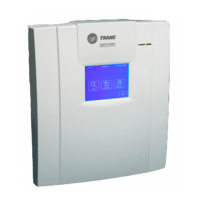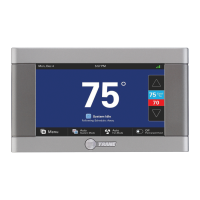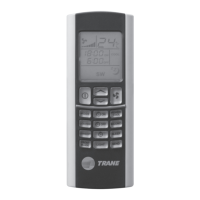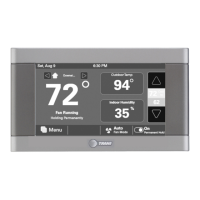Comm5 wiring
BMTX-SVN01C-EN 53
The decibel loss between any two devices is based on how well the termi-
nations or splices are made. A termination or splice can vary from
0.5–2 dB loss. A clean splice results in increased performance.
The CBL 75090-4, supported by Trane, has a power budget of 14 dB
between 32°F and 140°F (0°C and 60°C). This is the acceptable tempera-
ture range specified for the BCU. The decibel loss for conduit-rated fiber-
optic cable is 3.75 dB/km (1 km = 3,280 ft). Precut fiber-optic cables and
professionally spliced and/or terminated cables should ensure minimal
decibel loss.
To calculate the system loss, subtract the cable loss, splice loss, termina-
tor loss, and patch panel loss from the power budget. The example below
shows typical values for the UCM communication link.
power budget – system safety margin = available budget
14 dB – 3 dB = 11 dB (available budget)
available budget: 11 dB
cable loss: – 7.5 dB (1 km at 3.75 dB/km)
allowance for splice loss: – 1 dB (2 at 0.5 dB)
allowance for end connectors: – 1 dB (2 at 0.5 dB)
allowance for patch panel: – 1 dB (2 at 0.5 dB)
excess margin: = 0.5 dB
Zone sensor communication stubs on Comm5 links
The wire that runs from a zone sensor to a UCM is commonly referred to
as a communication stub. Figure 27 on page 54 shows an example of com-
munication stubs on a Comm5 link.
Comm5 links have specific limitations regarding stubs:
• A maximum of 8 stubs can be used per Comm5 link.
• The maximum length per stub is 50 ft.
• If a repeater is used, 8 stubs can be wired to either side of the
repeater, increasing the maximum number of stubs to 16.
In Figure 27, the total communication link length is 100+150+100=350.
In this example, the communication stubs are not included in the total
length of the communication link wire. Sites that require communication
at every zone sensor on the link must have their sensors wired into the
communication link daisy-chain. The length of each stub must be added
to the total length of the communication link wire.
The wire for the communication stub must be the same as that used for
Comm5 communication link wiring: low-capacitance, 22-gauge, Level 4
unshielded, twisted-pair. Existing sites that have already been wired with
low-capacitance, 18-gauge, shielded, twisted-pair with stranded, tinned-
copper conductors (Trane-approved, purple-jacketed wire) will use the
same wire for stubs. Thermostat wire is not allowed.
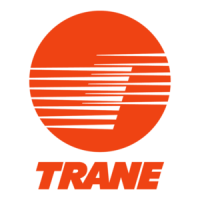
